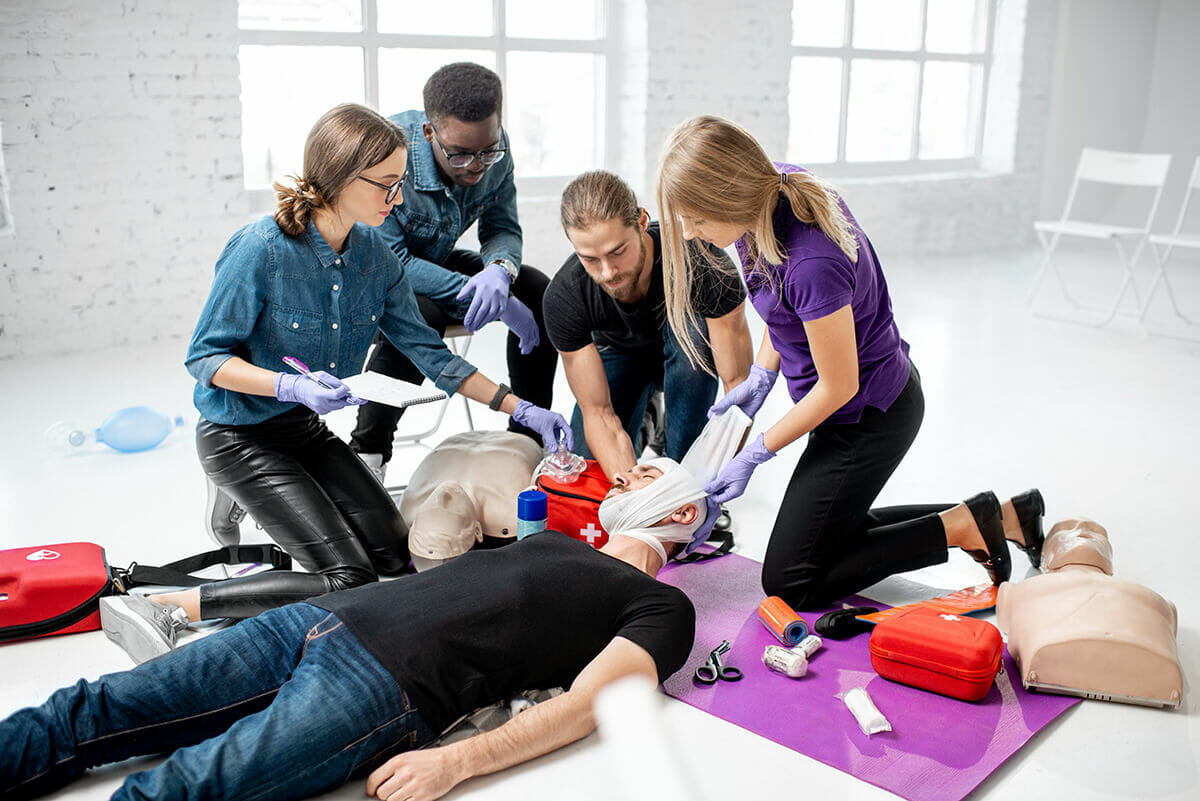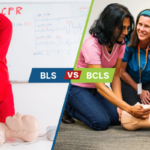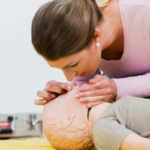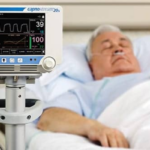
- Last Updated On: September 25, 2023
What’s the Difference Between CPR and First Aid?
A medical emergency can occur at any time. Whether it’s a cardiac arrest episode, choking, near-drowning event, or an open wound, you never know when medical training will be needed. It could be the difference between life and death. This is why so many individuals (even those outside of the medical community) are taking the time to receive CPR certification and First Aid certification. These medical training courses can provide anyone with the skills and knowledge to effectively respond to a range of emergencies. But what’s the difference between CPR training and First Aid training? If I take just one of these courses, don’t I learn basically the same information and skills? Are there any key differences between these two types of medical training? This blog answers these questions by examining the major differences and similarities between these classes.
The American CPR Care Association believes that making high-quality and professional CPR training widely available is the most effective way to address the rise in fatal cardiac arrest episodes. These courses provide you with the knowledge, skills, and hands-on training to help you respond effectively in a medical emergency. Hundreds and thousands of individuals lose their lives to cardiac arrest each year. This is why CPR certification and First Aid certification need to be available to everyone.
What’s the Difference Between CPR And First Aid?
Both CPR courses and First Aid training give people the tools to respond to medical emergencies. However, these two types of training diverge where CPR courses focus on responding to cardiac arrest episodes via cardiopulmonary resuscitation (CPR), while First Aid training incorporates a broader range of medical skills. In First-Aid classes, you’ll also learn how to bandage wounds, set broken bones, and respond to emergencies like poisoning or allergic reactions. Despite their differences, these two types of medical training have overlap. For example, if someone is choking, bystanders should be able to use both CPR and the Heimlich maneuver (First-Aid) to respond to the emergency.
What Do You Learn in A CPR Certification Course?
CPR certification courses prepare individuals to respond to cardiac arrest episodes. Thus, learning how to perform CPR on adults, children, and infants is the primary skill and focus of these classes. Since over 475,000 American lives are lost each year to cardiac arrest, this is certainly an important skill for anyone to acquire. CPR training focuses on teaching you how to safely and effectively perform CPR on a cardiac arrest victim—but that isn’t the only takeaway from these courses. CPR training also teaches you how to safely assess the scene of an emergency, ensuring that you don’t put yourself or others in harm’s way. These classes (which can now be completed remotely through online CPR courses) also identify key differences in performing CPR on an adult, child, or infant.
Many of these courses are also structured as CPR/AED classes, which also teach you how to use an automated external defibrillator (AED) on cardiac arrest victims. These small medical devices emit an electrical pulse that essentially resets the irregular heartbeat of the victim. CPR certification also includes instruction on responding to choking emergencies.
What Do You Learn in A First Aid Certification Course?
A First Aid certificate course provides you with the knowledge and skills to respond to a variety of medical emergencies, including burns, open wounds, and broken bones. However, much like CPR, First Aid is intended as a temporary measure for treating victims. In the event of a medical emergency, you should still call 911 immediately to ensure that professional medical attention will be on the way.
But this doesn’t mean that First Aid isn’t important. In fact, according to a Red Cross survey, almost 60 percent of deaths from injuries could have been prevented if First Aid had been used before paramedics could arrive. Countless lives could be saved if more bystanders were trained in the essential skills of First Aid. But what exactly do you learn in a First Aid certification course? Here’s a look at some of the emergency situations that a First Aid training class covers:
1. First Aid basics
It’s always important to start with the basics. First Aid training begins by covering the basic guiding principles that need to be followed in emergency situations. This includes assessing the scene, recognizing the problem, and how to determine when you should provide First Aid care.
2. Handling choking emergencies
Choking emergencies occur when an obstruction blocks the airway and a victim can’t breathe. First Aid teaches you when and how to provide abdominal thrusts in these scenarios. You will also learn whether CPR is a more effective technique to use.
3. Tackling Nervous system emergencies
Heart attacks, seizures, strokes, and spinal and head injuries are all classified as nervous system emergencies. First Aid training teaches you how to identify the differences and respond to each medical issue accordingly.
4. Handling allergy emergencies
A person with a severe allergic reaction may go into anaphylactic shock, which can cause difficulty breathing and a sudden drop in blood pressure. First Aid teaches you how to identify an allergy emergency and the correct usage of an epinephrine pen.
5. Caring for Bites and sting emergencies
Bites and stings are dangerous when they penetrate the skin, which could lead to an infection, or cause an allergic reaction. First Aid training instructs you how to respond to various types of bites and stings, including bees, wasps, jellyfish, and ticks.
6. Tending for Wound emergencies
First Aid training provides instruction on how to treat both open and closed wounds. This also includes nose bleeds and incidents when a victim is bleeding from the mouth.
7. Attending muscle and bone emergencies
Broken bones, dislocations, and sprains are all serious medical injuries. First Aid classes teach you how to safely respond to these injuries.
8. Handling burn emergencies
Blistering, red skin, swelling, and pain are all symptoms of a serious burn injury. Depending on the severity of the burn, there are specific actions you should take in responding to these medical emergencies.
9. Dealing with poisoning emergencies
Whether a poisonous substance is inhaled, absorbed, or injected, First Aid training teaches you how to respond to a poisoning event.
Conclusion
One useful way for understanding the difference between CPR and First Aid training is by comparing them as breadth vs depth. Receiving First Aid training provides you with more breadth because you cover a wider range of medical emergencies and skills. CPR training, on the other hand, goes to a much greater depth of training on just one primary skill.
While these two types of training are designed to respond to different emergency scenarios, it’s ideal for someone interested in medical training to receive certification in both courses. This ensures that you receive the most complete and comprehensive training. Both CPR and First Aid certifications are essential for anyone working in the medical field.
To help prepare bystanders to respond to emergency situations, American CPR Care Association is proud to offer 100 percent online CPR certification and First Aid certification courses. We also offer CPR/AED courses that train you how to properly use an automated external defibrillator (AED). Learning these valuable medical skills has simply never been this easy, convenient, or affordable. Register online today!
For more information on the full range of medical training classes that we offer, please visit our website or reach out to us at [email protected] or 1-888-808-9109. We look forward to helping you gain the skills, knowledge, and confidence to save lives.






